Harmony is the backbone of melody, and when you aim to evoke sadness and deep emotion in your music, understanding and utilizing sad guitar chords is essential. A chord, simply put, is a group of notes played together, and when you string these chords in a sequence, you create a chord progression. Certain chords inherently carry a melancholic weight, setting a somber tone for your compositions.
In this guide, we will explore five guitar chords renowned for their sad qualities and delve into five chord progressions that are guaranteed to inject emotional depth into your songwriting. While major chords and progressions are often associated with happiness, and minor with sadness, the reality is more nuanced. As we’ll discover, even major keys can be pathways to expressing profound sadness through carefully chosen chords and progressions.
What Makes a Guitar Chord Sound Sad?
The emotional color of a chord isn’t accidental; it’s built from several musical elements:
- The Minor Third Interval: This is arguably the most significant factor. The difference between a major and minor chord hinges on whether it uses a major or minor third. The minor third inherently sounds more somber.
- Dissonant Intervals: Introducing notes that create tension within the chord can amplify its sad quality. Dissonance adds a layer of unease and longing.
- Lower Voicing: Playing chords lower on the guitar neck, in a lower register, tends to produce a darker, heavier, and often sadder sound.
- Open Strings: The resonance of open strings can add a haunting quality to chords, contributing to their sad or reflective nature.
The following sad guitar chords effectively utilize one or more of these elements to create their emotional impact.
1. D minor
D minor is a foundational sad chord. It encompasses a minor third, is played with a low voicing, and incorporates an open string, making it inherently melancholic without relying on dissonance.
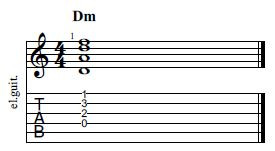 D minor chord diagram
D minor chord diagram
2. D sus 2
Suspended chords replace the third interval—major or minor—with a second or fourth. The D sus 2 chord achieves a dissonant quality by replacing the third, creating a suspended, unresolved feeling that leans towards sadness. Sus 2 chords often carry a slightly sadder tone compared to sus 4 chords.
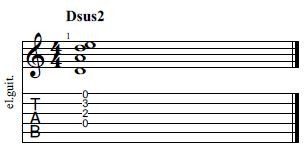 D sus 2 chord diagram
D sus 2 chord diagram
3. A minor add 9
Adding a major 9th (which is the same as a 2nd, but an octave higher) to a minor triad introduces dissonance and expands the chord’s emotional depth. Unlike sus 2 chords, the 9th in an add 9 chord doesn’t replace the third but is added to the existing minor triad, enriching its sorrowful character. The A minor add 9 contains both a minor third and a dissonant ninth, compounding its sad feel.
4. B min 7 (b5)
The B minor 7 (b5), also known as a half-diminished 7th chord, is rich in harmonic complexity. Often found in minor keys, it has a distinctly empty and depressing sound. This chord type is particularly effective in creating a sense of unease and melancholy.
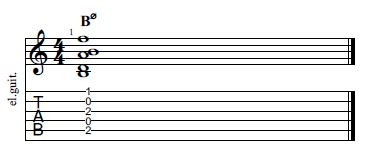 B min 7 (b5) chord diagram
B min 7 (b5) chord diagram
5. E minor 9
E minor 9 takes the minor add 9 chord a step further by including the 7th degree of the scale. This addition increases the internal dissonance, but instead of just sadness, it evokes a tense, anticipatory emotion. It’s a chord that suggests not just sadness, but a looming sense of foreboding.
Crafting Emotional Landscapes: Sad Chord Progressions
While individual chords possess their own emotional weight, their impact is amplified when used in progressions. A sequence of chords can tell a story, and even chords considered “happy” in isolation can contribute to a sad narrative when placed in the right progression.
Here are five chord progressions designed to evoke sadness, demonstrating how chord sequences can shape emotional musical journeys.
1. i – VI – v in A minor: Am – F – Em
Starting in a minor key is a direct route to sadness, and this progression in A minor is a classic choice for creating a depressing atmosphere. The movement from the tonic (Am) to the major VI (F) and then to the minor dominant (Em) creates a cyclical, melancholic feel.
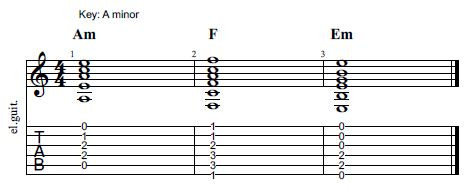 Am – F – Em chord progression diagram
Am – F – Em chord progression diagram
2. i – ii min 7 (b5) – v – i in D minor: Dm – E min 7(b5) – Am – Dm
This progression, entirely within the minor key and featuring a diminished chord, intensifies the sad emotion. The inclusion of the ii min 7 (b5) (E min 7(b5)) adds significant harmonic tension and a sense of unease, making it challenging to create anything but a somber mood.
3. I – iii – IV – V in C major: C – Em – F – G
While major keys are generally associated with happiness, they can also express sadness. This progression in C major utilizes the unexpected shift from the I chord (C) to the iii chord (Em). This move to the relative minor creates a poignant and melancholic touch within the brighter context of a major key. The subsequent IV (F) and V (G) chords resolve with a sense of longing rather than joy.
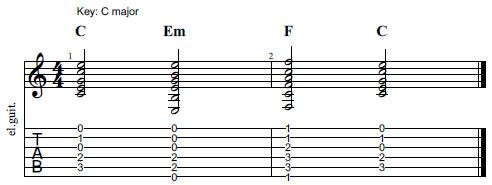 C – Em – F – G chord progression diagram
C – Em – F – G chord progression diagram
4. I – vi (add9) – IV in C major: C – Am add9 – F
Another technique to infuse sadness into major key progressions is through extended chords. Using an Am add9 as the vi chord in this C major progression adds a layer of complexity and melancholy. The added 9th in the Am chord creates a subtle dissonance that contrasts with the major key, resulting in a bittersweet and emotional feel.
5. IV – iv – I in A major: D – Dm – A
Known as the minor plagal cadence, this progression in A major borrows a chord from the parallel minor key. By substituting the major IV chord (D) with its minor counterpart (Dm), it introduces a sudden shift to sadness within the major key context. This unexpected minor chord creates a powerful emotional dip before resolving back to the major tonic (A).
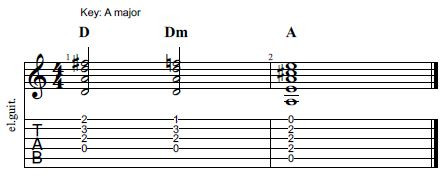 D – Dm – A chord progression diagram
D – Dm – A chord progression diagram
Beyond Harmony: Weaving Sadness into Your Music
While choosing sad guitar chords and progressions is crucial, crafting truly emotional music requires attention to other musical elements as well. Harmony is just one piece of the puzzle.
Here are additional techniques to enhance the sad and emotional impact of your music:
- Slow Tempo: A slower tempo generally conveys sadness and introspection, giving listeners time to absorb the emotional nuances of the music.
- Longer Note Durations in Melody: Melodies composed of longer notes can feel more drawn out and sorrowful, contributing to a sense of melancholy.
- Sad Scales: Explore scales inherently associated with sadness, such as the harmonic minor scale, to infuse your melodies and harmonies with a darker flavor.
- Emotional Phrasing: Utilize expressive techniques like string bending and vibrato to add human-like emotion and vulnerability to your guitar playing.
- Soft Dynamics with Accents: Primarily use soft dynamics to maintain a subdued and intimate feel, but strategically introduce accents to create emotional peaks and valleys.
- Lyrical Content: If your music includes lyrics, ensure they align with the sad and emotional tone you’re creating musically. Heartfelt and poignant lyrics can amplify the overall emotional impact.
By mastering sad guitar chords and progressions, and by thoughtfully incorporating these additional musical elements, you can unlock the power to create deeply moving and emotionally resonant music that speaks directly to the heart.
